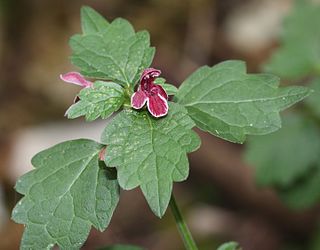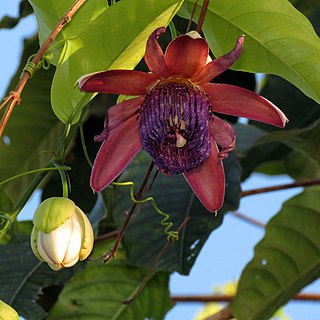Heliotropium pannifolium, the Saint Helena heliotrope, is now extinct but was formerly a hairy-leaved small shrub in the family Boraginaceae. It grew to a height of up to 1 m. It was only seen once, by the explorer W. Burchell in Broad Gut, Saint Helena and has never been seen again. Human impact on the island of Saint Helena was severe and the Saint Helena heliotrope is one of several extinct plants from that island.
Ormosia hosiei is a species of flowering plant in the family Fabaceae.
Excoecaria benthamiana is a species of flowering plant in the family Euphorbiaceae. It is endemic to Seychelles.
Polyscias crassa is a species of plant in the family Araliaceae. It is endemic to Seychelles. It is threatened by habitat loss.
Oreopanax sanderianus is a species of plant in the family Araliaceae. It is found in Guatemala, Honduras, and Mexico. It is threatened by habitat loss.
Phoebe bournei is a species of tree up to 20 metres (66 ft) tall in the family Lauraceae. It is endemic to China, where it occurs in Fujian, Guangdong, Guangxi, Guizhou, Hainan, Hubei, and Jiangxi provinces. It is threatened by habitat loss. The species is under second-class national protection in China.

Bulbophyllum comosum is a species of flowering plant in the family Orchidaceae.
Pentameris is a genus of plants in the grass family, native primarily to Africa, with a few species in Yemen and on certain islands in the Indian Ocean.

Dalbergia retusa is a plant species in the familyFabaceae . It is found in Pacific regions of Central America, ranging from Panama to southwestern Mexico. It produces the cocobolo wood. It is a fair-sized tree, reported to reach 20–25 m in height. This is probably the species contributing most of the wood in the trade. Because of the wood's great beauty and high value, the trees yielding this wood have been heavily exploited and are now rare outside national parks, reserves, and plantations.

Cornus controversa, syn. Swida controversa, is a species of flowering plant in the dogwood family Cornaceae. It is native to China, Korea, the Himalayas and Japan. It is a deciduous tree growing to 50 ft (15 m), with multiple tiered branches. Flat panicles of white flowers appear in summer, followed by globose black fruit. Ovate dark green leaves are glaucous underneath and turn red-purple in autumn. It is cultivated in gardens and parks in temperate regions.
Disa borbonica is a species of orchid in the Orchidaceae family. It is endemic to Réunion.
Mabrya erecta is a species of flowering plant in the family Plantaginaceae. It is an upright herbaceous perennial native to Mexico – the states of Chihuahua, Coahuila, Durango, Nuevo León and possibly México. Unlike other members of the genus Mabrya, it does not form mats. It has tubular flowers, whitish at the base and pink to red-violet at the apex. It was first described by William B. Hemsley in 1882 in the genus Maurandya and transferred to Mabrya by Wayne J. Elisens in 1985. The epithet erecta means erect or upright.

Loxocalyx is a genus of plants in the family Lamiaceae, first described in 1891. It is native to China and Japan.

Passiflora ambigua is a species of flowering plant in the family Passifloraceae . It is found in Mexico, Belize, Costa Rica, and Colombia.
Agrostis delislei is a species of flowering plant in the family Poaceae. It is endemic to the subantarctic Amsterdam Island. It was first described by William Hemsley in 1884.
Ainsliaea elegans is a species of flowering plants in the family Asteraceae. It is found in China and Vietnam.
Anaxagorea crassipetala is a species of understory tree in the family Annonaceae. It is found frequently in the lowland rainforests of Costa Rica and Panama, but extends down to Peru.

Cereus insularis is a species of columnar cactus in the family Cactaceae. It is found in Brazil.
Pentameris pictigluma is a species of flowering plant in the family Poaceae, native to Cameroon in West Africa, Ethiopia to Tanzania in East Africa, and Yemen. It was first described by Ernst Gottlieb von Steudel in 1854 as Aira pictigluma.





